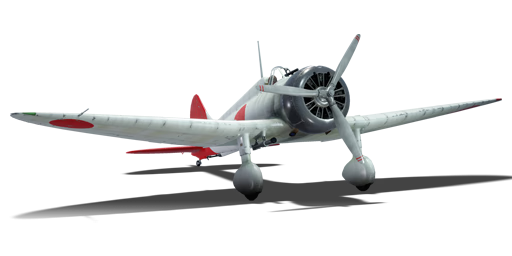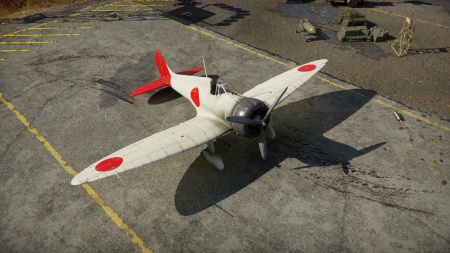A5M4
Contents
| This page is about the aircraft A5M4. For the premium variant, see Hagiri's A5M4. |
Description
The A5M4 is a rank I Japanese naval fighter
with a battle rating of 1.3 (AB/RB/SB). It was in the game since the start of the Open Beta Test prior to Update 1.27.
General info
Flight Performance
Describe how the aircraft behaves in the air. Speed, manoeuvrability, acceleration and allowable loads - these are the most important characteristics of the vehicle.
Stat card
| Characteristics | |||||||
|---|---|---|---|---|---|---|---|
| Stock | |||||||
| Max Speed (km/h at 2,900 m) |
Max altitude (meters) |
Turn time (seconds) |
Rate of climb (meters/second) |
Take-off run (meters) | |||
| AB | RB | AB | RB | AB | RB | ||
| 429 | 422 | 9,800 | 12.7 | 13.4 | 8.1 | 9.9 | 325 |
| Upgraded | |||||||
| Max Speed (km/h at 2,900 m) |
Max altitude (meters) |
Turn time (seconds) |
Rate of climb (meters/second) |
Take-off run (meters) | |||
| AB | RB | AB | RB | AB | RB | ||
| 466 | 447 | 9,800 | 12.1 | 12.3 | 19.7 | 12.8 | 325 |
Details
| Features | ||||
|---|---|---|---|---|
| Combat flap | Take-off flap | Landing flap | Air brakes | Arrestor gear |
| ✓ | ✓ | ✓ | X | ✓ |
| Limits | ||||
|---|---|---|---|---|
| Wing-break speed (km/h) |
Gear limit (km/h) |
Combat flap (km/h) |
Max Static G | |
| + | - | |||
| 558 | 558 | N/A | ~21 | ~8 |
| Optimal velocities | |||
|---|---|---|---|
| Ailerons (km/h) |
Rudder (km/h) |
Elevators (km/h) |
Radiator (km/h) |
| < 280 | < 320 | < 360 | > 180 |
| Compressor (RB/SB) | ||
|---|---|---|
| Setting 1 | ||
| Optimal altitude | 100% Engine power | WEP Engine power |
| 2,000 m | 690 hp | 787 hp |
Engine performance
| Engine | |||||
|---|---|---|---|---|---|
| Engine Name | Number present | ||||
| Nakajima Kotobuki 41 9-cylinder | 1 | ||||
| Engine characteristics | |||||
| Weight (each) | Type | Cooling | |||
| 350 kg | Radial | Air | |||
| Engine power (Stock) | |||||
| Mode | Max | Take-off | |||
| Arcade | 557 hp | 656 hp | |||
| Realistic/Simulator | 551 hp | 650 hp | |||
| Engine power (Upgraded) | |||||
| Mode | Max | Take-off | |||
| Arcade | 700 hp | 799 hp | |||
| Realistic/Simulator | 619 hp | 718 hp | |||
| WEP Duration | |||
|---|---|---|---|
| Arcade | Realistic/Simulator | ||
| 25 seconds | Infinite | ||
Survivability and armour
Like most Japanese planes, the A5M4 has no armour to protect the pilot and components of the plane. The best way to survive is to turn fight. I0in a dogfight, make sure you can see your enemy at all times because it will only take a few good hits to the pilot or components to put this plane out of action.
Armaments
Offensive armament
The A5M4 is armed with:
- 2 × 7.7 mm Type 89 machine gun, nose-mounted (500 rpg = 1,000 total)
Usage in battles
Fighter role, staying low and using the extremely quick turn times to get on the tail on the enemy is essential. Keep an eye on ammo levels and well as the surrounding, this is a extremely weak aircraft in terms of armour. It is relatively fast in a straight line, but not as quick as much of the opposition it will be facing in game. It is recommended to use the speed against biplanes as their turn times are nearly matched if not better as a monoplane.
Realistic battles
The A5M4 can accelerate to 350 km/h in just less than a minutes time from takeoff. Will climb up to 2500 m in around one minute and fifty seconds time when climbing in a 20 degree angle. Dive speeds are decent as the A5M4 will exceed 550 km/h in an 80 degree angle from just 2500 m height. Be careful though, once the A5M4 reaches 560 km/h, the plane will violently shake about and if the throttle isn't cut, the plane wings may rip off. Though speed can be gained in the dive, the energy is not easily retained, taking only a minute or so to fall to back to the maximum speed of 380 km/h with WEP or 360 km/h without.
Decent horse power with the typical Japanese light aircraft would give the idea that the plane would be great in the vertical axis dog fighting. With a problem with keeping constant fuel flow as the plane changes angle on its vertical access means it is better stick with horizontal dog fighting which isn't a bad thing as will outturn most all contemporary aircraft.
Simulator mode procedures
Hands-off carrier take-off (Auto engine control): Ignite engine, flaps: raised, elevator trim: 6% up, aileron trim: 0%, rudder trim: 21% right, WEP throttle, hands off controls until the plane lifts off the carrier.
Manual Engine Control
| MEC elements | ||||||
|---|---|---|---|---|---|---|
| Mixer | Pitch | Radiator | Supercharger | Turbocharger | ||
| Oil | Water | Type | ||||
| Controllable | Controllable Not automatic pitch |
Controllable | Not controllable | Combined | Not controllable | Not controllable |
Pros and cons
Pros:
- Great turn time
- Good Visibility (In cockpit view.)
- Low stall speed
Cons:
- No armour
- Poor pilot protection
- Low top speed (Due to fixed landing gear.)
- Poor gun cooling (easily jams from continuous fire.)
- Suffers from fuel starvation problems (RB/SB)
History
Encyclopedia Info
A single-seater, carrier-based, all-metal monoplane fighter with an open cockpit and fixed landing gear. The world's first carrier-based monoplane. A prototype of this fighter first flew on February 4, 1935. After extensive adjustments, the fighter was commissioned by the Japanese navy and designated Carrier Fighter Type 96 (A5M). Mass production began in the fall of 1936.
In 1938, the fine-tuned A5M4 (model 4, later re-designated the model 24) variant was launched. This model had several new features: a new, more streamlined cockpit canopy with improved visibility, advanced fairings, and a radio transmitter. Since bombers often had to operate in the dark, the plane had landing lights and lights for flights over the open seas at night. The plane was equipped with a film camera near the left of the landing gear.
The power plant was a 9-cylinder radial air-cooled Nakajima Kotobuki 41 with a rated capacity of 795 horsepower. The plane had a two-bladed (later three-bladed) wooden variable pitch propellor, the Sumitomo VDM. Later planes began to use the Kotobuki 41KAI engine (which had roughly the same power), a design designated as model 34.
The A5M's armament consisted of two fuselage-mounted synchronous 7.7mm Nippon-Seikosho type 89 model 2 (Vickers ""class E"") machine guns with 500 rounds of ammunition each. Two 30-kg type 97 bombs could be carried under the wings. Under the fuselage, an additional 160-liter fuel tank could be carried. Later, this fuel tank was increased in size to 210 liters.
The A5M fighter saw action over China from September 1937 to September 1941. It was also active early on in the war in the Pacific, used for some time to defend Japan and the Marshall Islands. Afterwards, it was used for training missions and flight school. In 1945, the remaining A5M fighters were used for kamikaze missions.
Overall, the A5M met the contemporary requirements for a fighter. It was stable and maneuverable and was easy to control. However, the fighter's construction did not easily allow for upgrades, and it quickly became obsolete. Its armament was poor, its armor non-existent, its fuel tanks not self-sealing, and its wings overly weak.
Production of the A5M ceased in 1941. A total of 1,095 A5M fighters (of all variants) were produced.
Media
Skin and Camouflages for the A5M4 in Warthunder Live.
See also
Links to the articles on the War Thunder Wiki that you think will be useful for the reader, for example:
- reference to the series of the aircraft;
- links to approximate analogues of other nations and research trees.
External links
| Japan fighters | |
|---|---|
| Navy | |
| Carrier-based fighter | |
| A5M | A5M4 · Hagiri's A5M4 |
| A6M | A6M2 mod. 11 · A6M2 · A6M3 · A6M3 mod. 22 · A6M3 mod. 22Ko · A6M5 · A6M5 Ko · A6M5 otsu · A6M5 Hei · A6M6c |
| A7He | A7He1* |
| A7M | A7M1 (NK9H) · A7M2 |
| Land-based Fighter | |
| J2M | J2M2 · J2M3 · J2M4 Kai · J2M5 · J2M5 (30 mm) |
| J6K | J6K1 |
| J7W | J7W1 |
| N1K-J | N1K1-Ja · N1K2-J · N1K2-Ja |
| Fighter seaplane | |
| N1K | N1K1 |
| A6M-N | A6M2-N |
| Army | |
| Ki-10 | Ki-10-I · Ki-10-I C · Ki-10-II · Ki-10-II C |
| Ki-27 | Ki-27 otsu · Ki-27 otsu Tachiarai |
| Ki-43 | Ki-43-I · Ki-43-II · Ki-43-III otsu |
| Ki-44 | Ki-44-I · Ki-44-I 34 · Ki-44-II otsu · Ki-44-II hei |
| Ki-61 | Ki-61-I ko · Ki-61-I otsu · Ki-61-I hei · Tada's Ki-61-I hei · Ki-61-I tei · Ki-61-II Otsu Kai |
| Ki-84 | Ki-84 ko · Ki-84 otsu · Ki-84 hei |
| Ki-87 | Ki-87 |
| Ki-94 | Ki-94-II |
| Ki-100 | Ki-100 · Ki-100-II |
| Other countries | ▅F4U-1A · ▅P-51C-11-NT · ▅Bf 109 E-7 · ▅Fw 190 A-5 |
| *Imported designation of the He 112 (A6M was in development - A7M would take A7 designation after the cancelation of the A7He) | |





